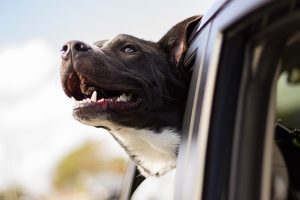 Pets are more than just animals that we keep in our homes. They’re companions, family members, and friends; which is why many people see no reason to leave their pets home alone when they have to go out-of-town. If you’re going to travel with your pet, though, it’s important to make sure you do it safely so that both they, and you, will enjoy the trip as much as possible. These travel tips are brought to you by USA Today, and Pets Welcome.
Pets are more than just animals that we keep in our homes. They’re companions, family members, and friends; which is why many people see no reason to leave their pets home alone when they have to go out-of-town. If you’re going to travel with your pet, though, it’s important to make sure you do it safely so that both they, and you, will enjoy the trip as much as possible. These travel tips are brought to you by USA Today, and Pets Welcome.
5 Safety Tips For Traveling With Your Pet
Tip #1: Make Sure You Bring Your Pet’s Papers
If you’re going to go out-of-town, you always bring your necessary documents with you. You know, your driver’s license, and if you’re going really far, your passport. Your four-legged companion doesn’t have pockets, though, so you need to carry the paperwork for them, too. You should have their recent vet records, proof of their shots and vaccinations, and any other documents you may need if something goes wrong and you need to either take your traveling companion to a veterinarian, or if your pet goes missing and you need to prove ownership once they’re found again.
Tip #2: Work Your Pet Up To Travel
Pets, as a general rule, like routine. That’s why it’s important to introduce changes slowly, and to get your pets used to it when it happens. After all, you can’t sit them down and explain that you’re going to get into a giant metal bird and fly halfway across the country, or make them understand that this time when you get into the car you’re going to be driving for a few hours instead of just going to the corner store.
For example, if you’re going to go on a long car trip, you need to work up your pet’s endurance for travel time. If you have a dog that enjoys time in the car, but you’ve never driven anywhere for more than 20 minutes, it’s a good idea to try a 40 minute trip, and then an hour-long trip, before going all the way to the other end of the spectrum and haring off on a multi-day road trip.
Tip #3: Use Proper Safety Harnesses
Your pets can’t wear car seat belts, but that doesn’t mean you should just let them sit in the passenger seat, or lay down on the back bench. Car accidents are serious risks that come with travel, and pets are at an even bigger risks than humans are for injury or death as a result. That’s why it’s important, when you travel, to make sure that your pet has a safety net to help prevent injuries.
For example, if you have a dog, you can get a safety harness that modifies the way your car’s seat belts work, thus allowing your canine copilot to stay in one piece of the unthinkable happens and you get in an accident. Alternatively, a traveling crate can provide a safer way for your pets to travel with you. Not only that, but if your pet is crate trained, it can provide a feeling of security and normalcy in an unfamiliar situation.
Tip #4: Medicine, Vet Clinics, and a First Aid Kit
Traveling with a pet takes a little more work than traveling with fellow humans. For example, if you’re on a trip and one of your bipedal friends gets hurt, you can just go to the hospital. Vet clinics are a little harder to find, though, even if the emergency is just as dire. That’s why, before you set off on your adventure, you need to check your destination to see what veterinary clinics are in the area. That way, if something does happen, you know where to go.
In addition to keeping a list of vet clinics in your bag, though, it’s important to make sure you have any medicine your pet needs on hand, and to pack a first aid kit. While there are some elements of first aid kits assembled for humans that can be used on anyone (gauze wrap is pretty universal), it’s important to make sure any chemicals in the kit are safe to use on your pet, should you need to.
Tip #5: Bring Enough Food And Water (And Get Your Pet Used To Eating On The Go)
Pets can sometimes be amazingly finicky, and it can cause no end to frustration for owners who don’t want to leave their animals home alone. For example, it may take some time to get your dog used to the idea that they have to eat somewhere other than at home. Drinking may be a similar issue, especially since it’s hard to keep a bowl of water on the back seat.
This is another one of those things you need to figure out before you go on a long trip with your pet. Some pets will be more than happy to gobble down lunch at a rest area, or from a bowl in the back seat, while others will be put off by doing it someplace that isn’t home.
If you’re serious about traveling with your pet, then you have to acclimate them to the road. Additionally, you have to be able to recognize the signs of your pet’s needs. How often do you need to stop to go to the bathroom, how often will you need to give them food and water, and what particular comfort methods work best to keep your pet happy during the trip? Sometimes all it takes is a favorite toy and a scritch behind the ears, but sometimes it takes more than that, and you need to know the tricks to keep your companion happy between point A and point B.

 Village...
Village... 
 The threat...
The threat...  When you...
When you...